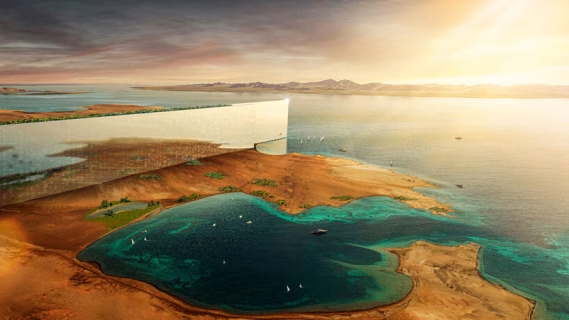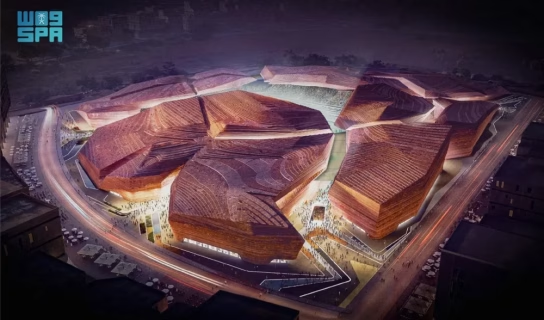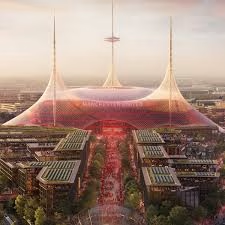Football fans, get ready to be amazed – the next generation of futuristic stadiums is on the way. Around the world, clubs and countries are planning or building futuristic new home grounds with cutting-edge architecture, high-tech features, and sustainable design.
But why this list, and why now? Because football isn’t just evolving on the pitch – it’s transforming in the stands, in the infrastructure, and in the entire experience surrounding the game. As countries gear up for future World Cups, and clubs chase the next generation of fans, stadiums are no longer just places to sit and watch – they’re becoming high-tech entertainment ecosystems. We’ve curated this list to spotlight the most visionary, football-specific projects on the horizon – stadiums that are not only ambitious in size and design but are pushing the boundaries of what a football venue can be. Whether it’s floating above a desert city or wrapped in petals and LED, these are the arenas redefining the beautiful game.
These 10 stadium projects (all under construction or planned) promise immersive fan experiences and bold innovation. Read on for highlights of each stadium’s specs, tech elements, and what makes it truly unique.

-
Grand Stade Hassan II – Benslimane, Morocco
One of the most ambitious football venues ever, Grand Stade Hassan II is being built east of Casablanca as Morocco’s flagship national stadium. Its massive 115,000-seat capacity would make it the largest in the world. The design features a giant conical roof inspired by traditional Moroccan tents that will tower over the pitch. Groundwork began in 2024, and the stadium is targeted for completion around 2027–2028. The venue uses low-carbon construction materials and aims for top-tier energy efficiency – reportedly 45–60% more efficient than typical buildings. It will anchor a 100-hectare sports/leisure district and is intended as a national icon and potential host of the 2030 World Cup final.
Status: Under construction
Timeline: Completion by late 2027–2028
Capacity: 115,000 (world’s largest)
Cost: ~$500 million
Futuristic features: Translucent tent-like roof; massive three-tier stands; advanced environmental systems for cooling and lighting
Why it’s special: Doubles Morocco’s current biggest stadium, symbolizes national pride, and is designed to co-host FIFA 2030
Read also: USC Advances $350M Reimagining of the Iconic Williams-Brice Stadium

2. King Salman International Stadium – Riyadh, Saudi Arabia
Saudi Arabia’s new King Salman Stadium is a 92,000+ seat powerhouse (the largest in the kingdom) set to open in 2029. Its petal-like design yields a dramatic “flower” form that seems to crack open the earth. Its cladding resembles cracked desert patterns covered with greenery, helping the stadium blend into the surrounding park. A shaded roof protects fans from desert heat, and a panoramic LED screen wraps inside the upper tiers. A gardened walking path on the roof gives spectators a park-like promenade with views of Riyadh. This venue will serve as Saudi’s football HQ for the 2034 World Cup.
Location: Northern Riyadh
Status: Design complete
Timeline: Opening late 2029
Capacity: ~92,760 seats
Futuristic features: Green “petal” architecture; shaded roof with integrated cooling; rooftop gardens; panoramic 360° screens; net-zero planning
Why it’s special: Riyadh’s flagship stadium blending sports and parkland; a key symbol of Saudi Vision 2030 and the 2034 World Cup bid

3. Flamengo New Stadium – Rio de Janeiro, Brazil
Brazil’s most popular club, Flamengo, is designing an 80,000-seat home ground with a vertical, tech-savvy layout. The club envisions a “Bernabéu-style” stacked design for maximum proximity to the pitch. A recent proposal includes a 78,000-seat arena with a Clube do Flamengo Museum, megastore, and rooftop walkway for fans. Futuristic features include 6,200 sqm of high-definition LED façade panels and a 360° wrap-around screen inside the bowl. The stadium will also function year-round as an entertainment complex and commercial hub.
Location: Rio de Janeiro
Status: Land purchase done; planning in progress
Timeline: Aimed for completion in 2029
Capacity: ~78,000 seats
Cost: ~$330 million
Futuristic features: Massive LED screens; 360° in-stadium video ring; museum and retail complex; rooftop trail
Why it’s special: A 24/7 football destination and entertainment hub in downtown Rio
Read also: Cleveland Browns Brook Park Domed Stadium To Proceed Without County Support
4. Guangzhou Football Park – Guangzhou, China
China is completing Guangzhou Football Park, a 73,000-seat stadium that was revived after a construction halt. The new design draws on Guangzhou’s nickname “City of Flowers,” with an undulating façade resembling a lotus flower. It’s billed as China’s largest soccer stadium, with a massive public plaza, museum space, and state-of-the-art lighting and tech systems.
Location: Guangzhou, China
Status: Under construction
Timeline: Completion by end of 2025
Capacity: ~73,000 seats
Cost: ~$328 million (revised)
Futuristic features: Blooming lotus-inspired roof; public spaces; LED lighting; modern fan amenities
Why it’s special: A revival project becoming a national football landmark

5. NEOM Stadium (“Stadium in the Sky”) – The Line, Tabuk Province, Saudi Arabia
The most radical on the list, the NEOM Stadium will be a football pitch 350 meters above ground, built into the roof of NEOM’s vertical city, The Line. Powered entirely by wind and solar energy, this venue will offer futuristic sky views, AI-driven transit access, and zero carbon emissions. After the 2034 World Cup, it will become home to a local team.
Location: NEOM, Tabuk Province
Status: Planned
Timeline: Construction from 2027; opening early 2030s
Capacity: TBD
Futuristic features: Stadium built into skyscraper roof; renewable-powered; panoramic cityscape views
Why it’s special: World’s first vertical skyscraper stadium – an architectural and engineering feat

6. New Murabba Stadium – Riyadh, Saudi Arabia
Part of the 400m x 400m New Murabba cube development, this 46,000-seat stadium will feature a rippled façade inspired by acacia tree bark. It will offer cutting-edge tech, flexible seating for multiple uses, and immersive fan zones. The surrounding district will include retail, residential, and green space as part of a city-scale megaproject.
Location: Downtown Riyadh
Status: Under site preparation
Timeline: Opening by 2032
Capacity: ~46,000 seats
Futuristic features: Petal-shaped exterior; immersive lounges and hospitality; energy-saving design; integrated urban hub
Why it’s special: Built within a futuristic cube city, blending sport, leisure, and urban life
7. New Milan Stadium – Milan, Italy
AC Milan and Inter Milan plan to replace San Siro with a sleek 71,500-seat stadium featuring a “covered ring” access plaza, underground parking, and 55,000 m² of public parkland. Designed for high-end hospitality and efficient access, the stadium will dramatically increase matchday revenue.
Location: Milan
Status: Planning underway
Timeline: 2027–2030
Capacity: ~71,500 seats
Cost: €1–1.5 billion
Futuristic features: Grand access plaza; LED display rings; hybrid pitch; VIP suites; smart infrastructure
Why it’s special: Joint home of two legendary clubs, supporting urban renewal and commercial growth
8. Nou Mestalla – Valencia, Spain
After years of delays, Valencia CF’s Nou Mestalla is finally under construction again. The 70,000+ seat stadium will open in 2027, just in time for the World Cup cycle. With a continuous cantilever roof and modern amenities, the stadium will allow Valencia CF to boost revenues and match international standards.
Location: Valencia
Status: Under construction
Timeline: Completion by 2027
Capacity: ~70,000+ seats
Cost: ~€300 million
Futuristic features: Modern roof and stands; energy-efficient systems; mixed-use development
Why it’s special: A comeback story for a historic club and a venue worthy of elite international matches
9. Nuevo Ramón Sánchez-Pizjuán – Seville, Spain
Sevilla FC will demolish and rebuild its iconic home as the Nuevo Sánchez-Pizjuán. The new 55,000-seat venue will feature sustainable design, enhanced accessibility, and improved fan experiences. Construction begins in 2026 and finishes in 2028.
Location: Seville
Status: Planned
Timeline: 2026–2028
Capacity: ~55,000 seats
Cost: €300–350 million
Futuristic features: Eco-friendly construction; smart ventilation; advanced access and viewing systems
Why it’s special: A modern cathedral for Andalusian football, honoring history while pushing into the future

10. New Trafford Stadium – Manchester, England
Manchester United unveiled plans for the New Trafford Stadium, a groundbreaking project set to redefine football venues globally. With an estimated cost of £2 billion ($2.6 billion), this 100,000-seat arena is poised to become the largest stadium in the United Kingdom, surpassing Wembley Stadium. Designed by the renowned architect Norman Foster, the stadium will feature a distinctive ‘trident’ structure—three towering masts visible from 25 miles away—symbolizing the club’s ambition and heritage. The design includes a vast 126,000 square meter canopy, under which will reside a commercial quarter filled with entertainment and retail venues, creating a year-round destination for fans and visitors alike.
The pitch will be situated 15.9 meters below ground level, enhancing sightlines and atmosphere. Construction is anticipated to commence soon, with completion aimed for the 2030–31 season. This project is not just about building a stadium; it’s about revitalizing the surrounding area, drawing inspiration from developments like Los Angeles’ SoFi Stadium, and positioning Manchester United at the forefront of football innovation.
Status: Planned
Timeline: Construction to begin soon; completion by 2030–31 season
Capacity: 100,000 seats
Cost: Approximately £2 billion ($2.6 billion)
Futuristic features: Iconic ‘trident’ masts, expansive canopy covering a commercial district, subterranean pitch design
Why it’s special: Aims to be the world’s premier football stadium, blending cutting-edge design with community regeneration

